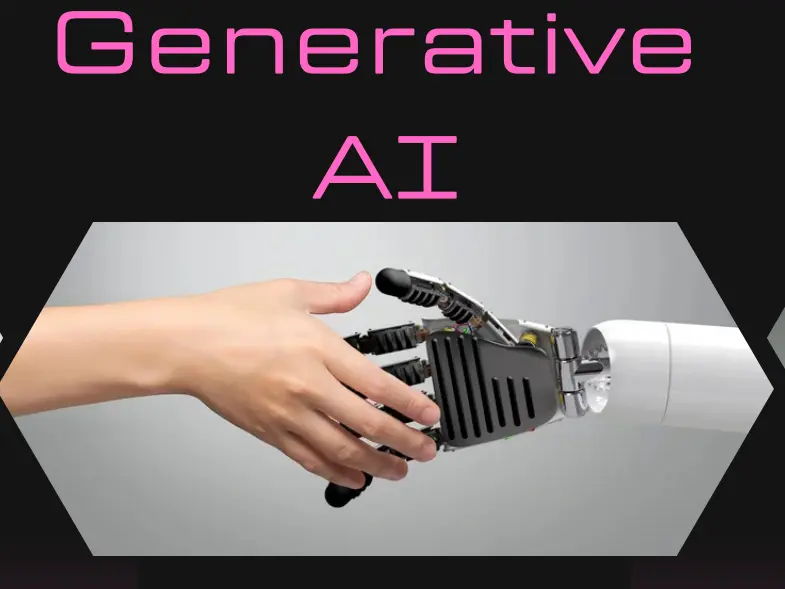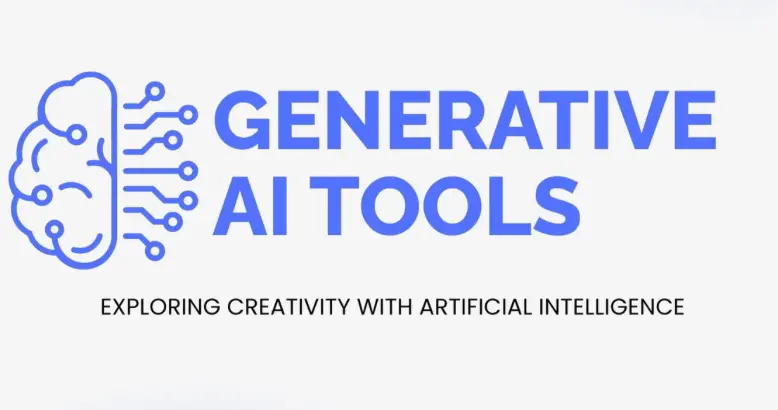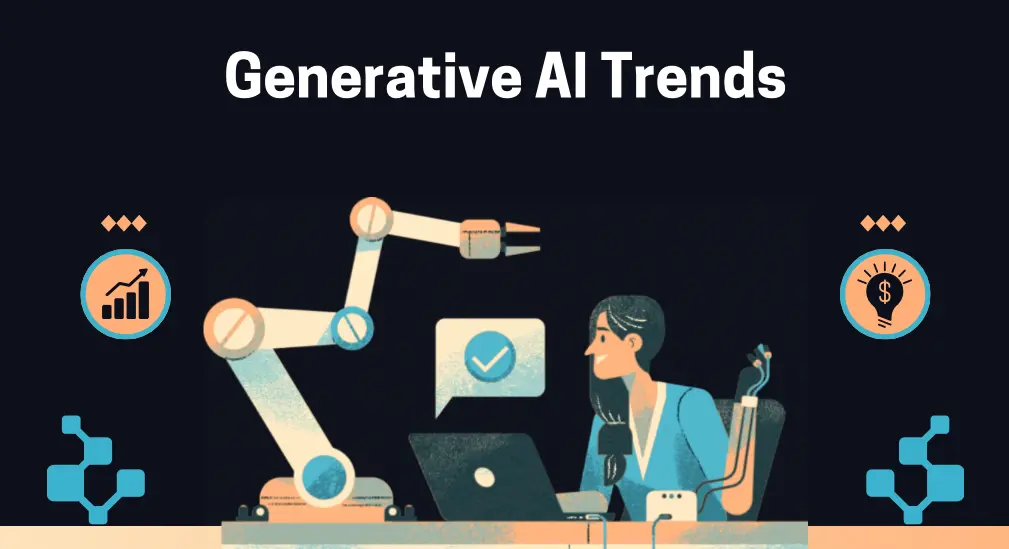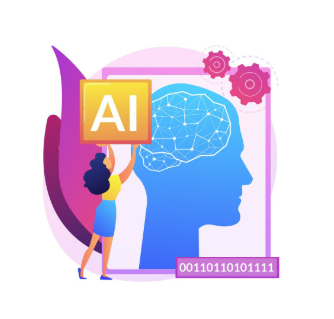The world of technology is changing faster than it has ever been, and the soul of this transformation is the new Avatar of AI i.e. gen ai. We are from the land that is the treasure of many scriptures and art forms. The same scripture can be the stepping stone for the advanced study of the concept or can inject some amount of genius for other written works. With the advent of technology all written works from all different fields have been transformed into soft copies. This digital preservation not only safeguards them for future generations but also makes them widely accessible at a prompt or just a click of a button. Generative AI has become one of the most talked-about innovations of the present time, and this year it is impossible to ignore the trends it has set for the industry.
In simple words, generative AI refers to tools and systems that can generate new content. This can be text, image, video, or even music. However, the problem lies in the fact that with such magnificent development, many people are unsure as to how to keep up with the constant changes. Believe you me, the opportunities are immense, but there are questions prevailing about the authenticity and over-dependence on machines for creativity.
This blog is going to give a clear view of the Latest Trends In Generative AI that matter right now. From generative AI-driven content for businesses, to personalised learning solutions, to the rise of multi-modal that combines text, images, and voice, the trends are reshaping how we work and interact. It brings home more transparency and accountability than ever. Instead of being overwhelmed, this blog brings in awareness that staying ahead in the rapidly evolving digital world is only through generative AI.

Genesis of Generative AI
The term “Artificial Intelligence” was first coined by John McCarthy at the Dartmouth Conference in 1956, which is actually considered the birth of AI as a field. From 1956-70, researchers built simple programs that could do algebra problems, or solve mathematical theorems, and could do speech recognition and problem-solving systems. This resulted in the invention of calculators, watches, and computers. Also, ELIZA was invented in 1966, which was the first chatbot that mimicked human conversation. AI saw slow progress from 1970-90s; however, AI programs for medicine, engineering, etc., continued silently. AI started making a comeback with machine learning and big data from 2000 onwards.
Finally, from 2014 onwards, the Generative AI and advanced large language models(LLMs) were pushed into the mainstream. However, here we should remember that the true spark of Modern Generative AI came from Lan Goodfellow in 2014, when he invented GANs(Generative Adversarial Networks).
Generative AI Meaning
Generative AI is a sub-section of Artificial Intelligence, which is focused on creating new and unique content as per the prompts given by the human mind. The types of content that can be created by it are text, images, music, video, code, and whatnot. It uses large datasets and models like GPT, DALL-E, and Stable Diffusion to generate new content.
Generative AI Examples
- ChatGPT. It generates a human-like text when given an appropriate prompt.
- DALL.E/ Mid Journey. It creates artistic or realistic images from just a text prompt, which is mind-blowing.
- Runaway ML. It edits and even generates video, which is used in creative industries.
- Suno AI/ Jukebox. It generates and edits music or audio, which is known for its originality.
- Synthesia/ DeepBrain AI. It creates AI-generated videos with virtual avatars.
- Descript/ Podcastle. It generates and edits voice/ audio with AI.

Generative AI Trends
1. AI-Powered Content Creation
Text, visuals, videos, and even music composed by Generative AI at an individual’s prompt are surely redefining creativity. Content creators, marketers, and educators are using AI tools to produce high-quality content. However, originality, copyright, and transparency are some issues that will be at the forefront of discussions this year.
2. Hyper Personalisation in Customer Experience
Today, businesses are realising that personalisation goes far beyond using a customer’s name in an email. Generative AI can now analyse a customer’s behaviour, predict his or her needs, and create tailored product recommendations or content in a real-time scenario. From e-commerce to streaming platforms, hyper-personalisation is becoming the need of the hour. It is surely making the customer journey smoother and more engaging.
3. Personalised Learning
Generative AI is making learning more interactive and personalised than it was ever before. Students are now receiving customised study materials, real-time feedback, and even language tutoring tailored to their pace. This is incredibly the best gift for the new generation. Also, for the educators, generative AI offers support in curriculum design and assessment. This opens the doors to an inclusive education system.
4. Generative AI in the Workplace
Generative AI is no longer just an assistant wherein you give a command or a prompt and it produces the requisite output. It is now a collaborator in all your moves. Whether it’s drafting reports, designing presentations, or even assisting in coding, generative AI tools are helping professionals save time and focus on high-value tasks. The rise of AI-generated copilots in industries like finance, law, the education sector, and healthcare is transforming workflows. This is surely enhancing the efficiency across sectors.
5. Multi-modal Models
Multimodal models can understand and generate content across several forms of data at one go. A single system can read a prompt, analyse an image, listen to audio, and then respond by combining these inputs into a meaningful output. This ability is proving to be extremely powerful in real-world applications. In the education sector, Generative AI Can Create Multimodal Models for an interactive learning experience where students learn through text, visuals, and speech altogether, making concepts easier to grasp. Even in everyday use, tools combine voice command with visual outputs, thereby making it more natural. Mutimodal models are bridging the gap between human communication and machine understanding.
6. Ethical AI and Transparency
As the adoption of gen AI is leaping ahead, so are the concerns about the misinformation, bias, and misuse of it. Surely, the Government and institutions have to introduce regulations to ensure that the generative AI remains safe, fair, and accountable. Companies investing in transparent and ethical AI practices will not only build trust but will also set industry standards to emulate.

Top 5 Generative AI Courses and their Course Fees in India

Generative AI Course by Henry Harvin
Henry Harvin is undoubtedly one of the leading EdTech Institutes that is recognised worldwide. Based in India and the US, it has many courses to offer. Henry Harvin is a private company that is well-affiliated with the Government of India and NSDC. It offers a Tailor-Made Latest Generative AI Course which includes 32 hr of two-way live interactive sessions. It will make you learn the essential tools like Python, Tensorflow, PyTorch, and Hugging Face. So take a plunge in learning core generative models, viz GANs, VAEs, LLMs, and Transformers, to create original content suiting your requirements. Also, you will explore real-world industry uses in fields of healthcare, marketing, gaming, and much more.

Conclusion
Generative AI is not just another trend. Surely, it is a force that is shaping industries, redefining creativity, and transforming everyday life. The trends emerging this year highlight a shift from experimentation to adoption for advancement. So for professionals, businesses, and learners alike, one message is pretty clear that Ignoring Generative AI is no longer an option. It is a shift in how we think, create, and work. By understanding the new developments in this field, we can approach Gen AI not with fear but by being mindful of ethics and responsibility. And surely, with confidence and familiarity, to use Generative AI as a tool to stay relevant and keep pace in today’s digital age.
“When innovation meets imagination, then surely Generative AI leads the way.”
Recommended Reads
- Why Is Generative AI Important?
- Generative AI: How It Works, History, and Pros and Cons
- Deep Learning Vs Machine Learning: The Ultimate Guide
- Current and Future Trends of Artificial Intelligence
- Top 15 Artificial Intelligence Courses Online
- Applied AI Course Review: Insights and Analysis
FAQs
Ans. It is doing the dual role. In one way, it gives us the fastest way to brainstorm, design, or write. On the other hand, it throws challenges at us to bring in the originality with a human touch. So it is about co-creating things and surely not just competing.
Ans. It is because these models can handle images, audio, and even video in one place. It means smoother interactions.
Ans. Companies or even retailers are using generative AI to create personalised shopping recommendations, banks use it for fraud detection, and even small businesses are using it to draft marketing content. It is now more of a real workplace tool.
Ans. The growing concerns are around fakes, misinformation, and data privacy. It surely calls for regulations and ethical guidelines on its usage.
Ans. The human edge will come from using gen ai and not by just knowing the fact that it exists.










Recent Comments